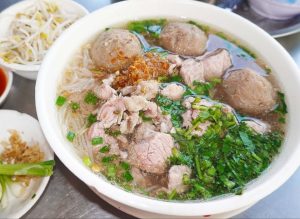magiccarouselsundays.com – Kuy Teav, pronounced “kway tiao,” is a beloved Cambodian noodle soup that holds a special place in the hearts of locals and visitors alike. This comforting and flavorful dish is a quintessential part of Cambodian breakfast culture, offering a warm and satisfying start to the day.
A Culinary Tapestry
Kuy Teav is a testament to the diverse culinary influences that have shaped Cambodian cuisine. Its origins can be traced back to Chinese influences, evolving over time into a distinctly Khmer dish. The result is a harmonious blend of flavors and textures that reflect the rich tapestry of Cambodian culture.
A Broth of Delights
At the heart of Kuy Teav lies a flavorful broth, typically made from pork bones simmered for hours with aromatic spices and herbs. This rich and savory broth provides the foundation for the dish, infusing each element with its comforting warmth.
A Noodle Dance
The broth is then filled with delicate rice noodles, known for their smooth texture and subtle sweetness. These noodles, often served al dente, provide a delightful contrast to the savory broth and the various toppings.
A Feast of Toppings
Kuy Teav is a canvas for culinary creativity, with a wide array of toppings available. Common choices include:
- Pork: Tender slices of pork, often including pork belly, ground pork, and pork balls, add a savory richness to the soup.
- Seafood: Shrimp, squid, and fish balls offer a delightful seafood twist, adding a briny flavor to the broth.
- Garnishes: Fresh herbs like cilantro, spring onions, and bean sprouts add a refreshing crunch and vibrant aroma.
- Other additions: Depending on personal preference, diners can add their own touches, such as a squeeze of lime, a dash of fish sauce, or a sprinkle of chili flakes.
A Culinary Tradition
Kuy Teav is more than just a breakfast dish; it’s a cultural experience. The act of savoring a bowl of Kuy Teav often involves social interaction and a sense of community. Whether enjoyed at a bustling street stall or a cozy family table, Kuy Teav fosters a sense of connection and shared culinary heritage.
A Taste of Cambodia
Whether you’re a seasoned traveler or a curious foodie, Kuy Teav is a must-try dish. Its comforting flavors, diverse toppings, and cultural significance offer a truly authentic taste of Cambodian cuisine. So, the next time you find yourself in this beautiful country, be sure to savor a bowl of Kuy Teav and experience the magic of Cambodian breakfast.
Additional Notes:
- Kuy Teav is typically enjoyed for breakfast, but it can also be found as a lunch or dinner option in some establishments.
- The dish is incredibly versatile and can be customized to suit individual preferences.
- Kuy Teav is a popular choice for a quick and satisfying meal, making it a favorite among locals and tourists alike.
By understanding the history, ingredients, and cultural significance of Kuy Teav, we can gain a deeper appreciation for this beloved Cambodian dish and the rich culinary traditions it represents.



